Martienssen W., Warlimont H. (Eds.). Handbook of Condensed Matter and Materials Data
Подождите немного. Документ загружается.

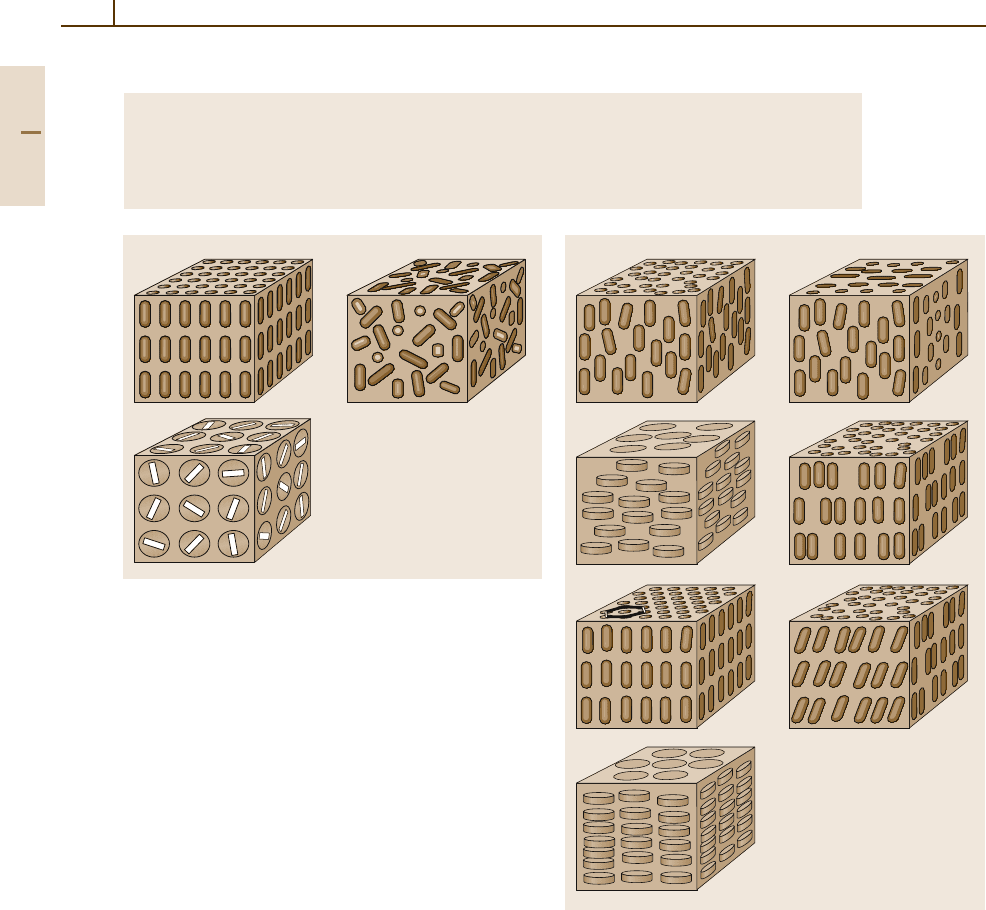
942 Part 5 Special Structures
Table 5.1-1 Classifications of liquid crystals
Shape Rod-like molecules Disk-like molecules
Phase structure Calamitic liquid crystals Discotic liquid crystals
Mesophase units Thermotropic liquid crystals Lyotropic liquid crystals
Mesophase origin Amphiphilic liquid crystals Monophilic liquid crystals
a) b)
c)
Fig. 5.1-1a–c Types of states: (a) crystal, (b) isotropic li-
quid,
(c) plastic crystal
(Fig. 5.1-2b). Here the orientation of the director does
not apply to the whole medium but rather to a virtual
layer. Perpendicular to this layer, the director follows
a helix with a certain pitch. In the case of the blue phases,
such a helical structure is formed not in one but in all
three dimensions. Thus, highly complex arrangements,
with chiral cubic symmetry in most cases, are generated.
Not only rod-like but also disk-like molecules can form
nematic phases. The discoid nematic phase is shown in
Fig. 5.1-2c.
Rod-like molecules arranged in layers form smectic
phases. They are subdivided into a considerable number
of different species. These classifications result from
various arrangements of the molecules within the lay-
ers and different restrictions on their movement. The
smectic A phase, the simplest smectic phase, can be re-
garded as a two-dimensional liquid. The molecules are
arranged normal to the layers (Fig. 5.1-2d). The smec-
tic B phase can be interpreted as the closest packing of
rod-like molecules, so that within a layer each molecule
has a hexagonal environment (Fig. 5.1-2e). The smectic
A phase and the smectic C phase are similar, except that
in the latter the molecules are tilted within the layers
by a tilt angle (Fig. 5.1-2f). A particular case of smec-
a)
c)
e)
g)
b)
d)
f)
Fig. 5.1-2a–g Types of mesophase: (a) nematic, (b) chol-
esteric,
(c) discoid nematic, (d) smectic A, (e) smectic B,
(f) smectic C, (g) discotic
tic C is the chiral smectic C
∗
phase, where the tilt angle
varies from layer to layer, forming a helical structure.
For discussion of other smectic phases, as well as their
further subclassification, the reader should consult the
references [1.15,16].
In discotic phases, the disk-like molecules are
arranged in columns. In this group, again various
phases are possible, depending of the orientation of
Part 5 1.1

Liquid Crystals 1.1 Liquid Crystalline State 943
the molecules within the columns and the order be-
tween the columns. The simplest phase is the hexagonal
columnar discotic phase. It can be regarded as a one-
dimensional liquid. The columns have a hexagonal order
(Fig. 5.1-2g).
Lyotropic liquid crystals are formed by aggregation
of micelles. They are multicomponent systems. Nor-
mally they consist of an amphiphilic substance and
a solvent. In contrast, thermotropic liquid crystals are
individual compounds.
Enantiotropic LC phases are formed during both the
heating and the cooling process. Monotropic LC phases
exist only in the supercooled state below the melting
point. Thus, these phases are observed during cooling
only.
5.1.1.1 Chemical Requirements
A liquid crystalline compound can be divided into the
mesogenic group and the side groups. The mesogenic
group is subdivided into fragments of rings and bridges.
The side groups are subdivided into links and terminal
groups.
Many other types of liquid crystalline com-
pounds exist besides those with rod-like molecules e.g.
compounds with disk-shaped, banana-shaped, and bowl-
shaped molecules. However, over 80% of all liquid
crystals have a rod-like form (e.g. the molecule shown
in Fig. 5.1-3).
5.1.1.2 Physical Properties of Liquid Crystals
The order parameter S = 0.5(3cos
2
Θ−1) character-
izes the long-range order of molecules in a mesophase,
where Θ is the momentary angle between the long axis
of the molecule and the director. In an ideal crystal the
order parameter S equals 1, and it equals 0 in an isotropic
liquid. In a nematic phase the order parameter lies in the
range 0.5–0.7.
One of the most useful properties for the application
of liquid crystals is the anisotropy of their refractive in-
dex ∆n =n
e
−n
o
, where n
e
is the extraordinary and n
o
Link Bridge Ring Terminal group
Side group
L
Mesogenic group Side group
R
CH O CHN
613
C
O
OOCH
613
Fig. 5.1-3 Structure of a calamitic mesogenic compound
is the ordinary refractive index. For nematics, n
e
corres-
ponds to n
and n
o
= n
⊥
.Forn
⊥
the vibration vector
of plane-polarized light is perpendicular to the optical
axis, i. e. the director, while for n
the vibration vec-
tor of plane-polarized light is parallel to the director.
For the majority of LCs the value of ∆n is positive, but
cholesteryl-substituted compounds are optically nega-
tive (∆n < 0). On increasing the wavelength, ∆n usually
decreases. For homologues ∆n decreases as the length
of the alkyl chains increases.
The orientation of molecules in an electric field
is determined by the sign of the dielectric anisotropy
(∆ε = ε
−ε
⊥
); ε
and ε
⊥
are the dielectric constants
measured parallel and perpendicular to the director.
Some nematic LCs can change their sign of ∆ε de-
pending upon the frequency of the applied field.
The majority of mesogens are diamagnetic. The
diamagnetic anisotropy (∆χ) characterizes the behav-
ior of a LC under the influence of a magnetic field;
∆χ = χ
−χ
⊥
, where χ
and χ
⊥
are the diamagnetic
susceptibilities parallel and perpendicular to the director.
The basic methods for the determination of phase
transition temperatures (T
tr
) are DSC (differential scan-
ning calorimetry), DTA (differential thermal analysis),
and polarization microscopy. Every method has its ad-
vantages and restrictions. DSC allows one to determine
the enthalpies of phase transitions (∆H
tr
). Microscopy
allows one both to determine the phase transition tem-
peratures and to identify the type of mesophase. DTA
gives reliable results for melting temperatures of LCs
that show solid-state polymorphism, and of LC mixtures.
The differences in T
tr
that can be found in publications
by different authors arise from different measurement
techniques and the presence of impurities. We have
selected the data with the higher T
tr
values in such cases.
The temperature dependence of the density ()is
practically linear, with the exception of jumps near
phase transitions. The volume changes are 3–9%,
0.1–0.4%, and 0.01–0.2% for the crystal–mesophase,
nematic–isotropic, and smectic A–nematic transitions,
respectively.
The kinematic and dynamic viscosities ν and η,re-
spectively, can be determined by a capillary viscometer
of the Ubbelohde or Ostwald type (ν =η/).
The surface tension (γ
LV
) influences the angle be-
tween the surfaceand the nematic-phase director. It plays
an important role in the selection of coatings for the cre-
ation of homeotropic alignment (where the molecules
are perpendicular to the cell surfaces) or planar align-
ment (where the molecules are parallel to the surfaces)
of LCs. The Friedel–Creagh–Kmetz rule states that if
Part 5 1.1

944 Part 5 Special Structures
γ
L
(energy of LC–surface interaction ) >γ
S
(solid sur-
face energy), then a homeotropic alignment is induced;
otherwise, a parallel alignment is induced.
5.1.1.3 Applications of Liquid Crystals
The main requirements on LC materials (LCMs) for
electro-optics are ahigh clearing temperature (T
N-Is
)and
low melting temperature, i. e. a wide temperature range
of definite liquid crystalline phases, and a low viscosity
for reducing the switching time of electro-optical effects.
Wide usage of LCMs in displays became possible after
the discovery of mesogenic cyanobiphenyls. At present
many of homologous LCs are synthesized for display
applications. Phenylcyclohexane- and bicyclohexane-
substituted LCs are used as components in LCMs; they
have low viscosity and, accordingly, fast switching.
Fluorinated three-ring LCs containing two cyclohex-
ane rings and a phenyl ring are used in LCMs with
high dielectric anisotropy, which are used at low volt-
ages. For the application of a LCM as a material in LC
displays, many properties have to correspond to rigid
specifications. For this reason LCMs consist typically
of 7 to 15 components. Sometimes LCMs contain non-
mesogenic additives, e.g. to reduce the viscosity of the
mixture.
In the twist structure, the molecules are parallel to
the cell surfaces and the angle between the boundary
directors is 90
◦
. In the S effect (Frederics effect), a pla-
nar structure is transformed to a homeotropic one, and
in the B effect, a homeotropic structure is transformed
to a planar one. In the twist effect (or twisted nematic,
TN, effect) a twist structure turns into a homeotropic
one. The disadvantage of the TN effect is the necessity
to use polarizers. The “dynamic scattering mode” of use
of LCs depends on the influence of an electric current
on the orientation of the molecules. At a high enough
voltage, transparent nematic cells becomes turbid. A dis-
advantage of this effect is that the lower the voltage, the
longer the time of switching. One of the modern uses
of this effect is use of the dynamic scattering mode for
data storage. After the applied voltage is switched off,
the mode of the planar cell does not return to its initial
state. The cell can be stored in the turbid state for a long
time (from some minutes to some months).
The host–guest effect results from a reorientation of
dye dopants (1–2% in the LC matrix) in an electric field.
In this case the wavelength of maximum absorption of
light is shifted and the color of the LC cell changes.
The sign of the dielectric anisotropy of a LCM de-
termines the type of electro-optical effect. LCMs with
∆ε>0 are used for the TN (twisted nematic), STN
(supertwisted nematic), and TFT (thin-film transistor)
effects. LCMs with low negative values of ∆ε were
formerly used for the dynamic scattering mode. Now
LCMs with negative anisotropy ∆ε are utilized for
MVA-TFT (multidomain vertical-alignment thin-film
transistor) displays. The higher the value of ∆ε>0,
the smaller the working voltage.
Electric current leads to degradation of a LCM
and reduces the lifetime of the display. Impurities in-
fluence the stability of the material and accelerate
electrodegradation. Therefore a multistage purification,
consisting for example of recrystallization, and col-
umn chromatography, to remove conducting impurities
(intermediate products, water, and CO
2
), is necessary.
Usually the specific conductivity of a LCM is lower than
10
−11
–10
−12
Cm/cm and corresponds to the intrinsic
conductivity.
The elastic constants (K
i
) determine the switching
time of the electro-optical effects. The elastic con-
stant K
1
corresponds to the S effect, K
3
to the B effect,
and K
2
to the TN effect; here K
1
corresponds to splaying
K
2
to twisting, and K
3
to bending [1.11,12].
Cholesteryl compounds were the first materials that
found application in thermography.
A huge number of other applications exist, where the
chemical and physical requirements are totally differ-
ent. These applications include reflectors, temperature
measurement with thermochromic materials, nonlinear
optics, polymer materials, SAMs (self-assembled mono-
layers) and LB (Langmuir–Blodgett) films, the use of
liquid crystals in template synthesis of porous materials,
drug delivery, and many more.
5.1.1.4 List of Abbreviations
Cr, Cr
crystalline phases
S smectic
A, B, C, E, F, G, H specific smectic mesophases
C* chiral smectic C (ferroelectric)
D discotic
Part 5 1.1
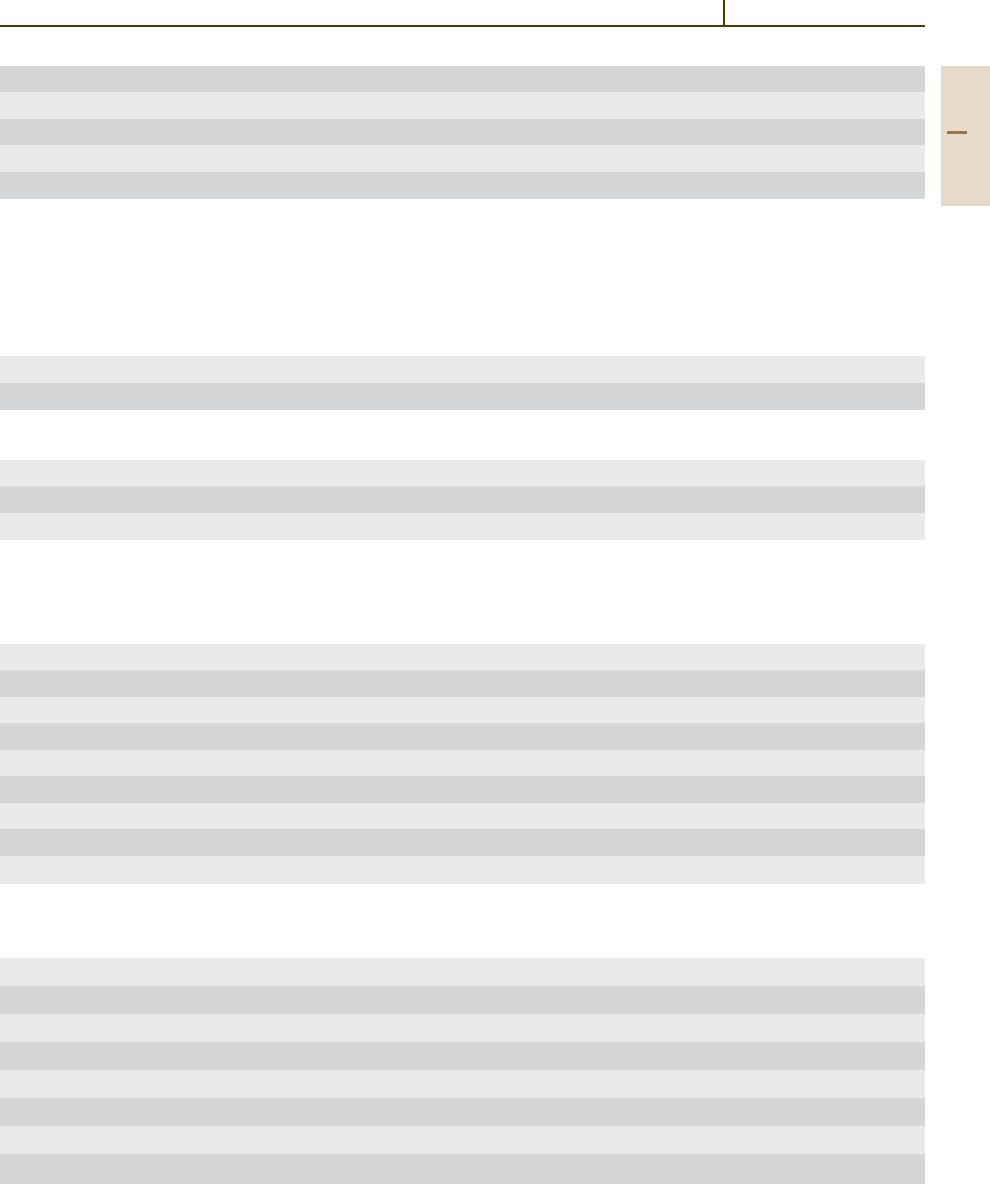
Liquid Crystals 1.1 Liquid Crystalline State 945
Dh, Dho, Dhd hexagonal columnar discotic (ordered or disordered)
Dr, Dt rectangular, tilted columnar discotic
N nematic
N* cholesteric
Is isotropic
Examples
Cr 95.0 C 99.0 N 107.5 Is Crystals melt at 95
◦
C, smectic C transforms to nematic at 99
◦
C and to isotropic liquid
at 107.5
◦
C.
Cr
5.0 Cr 67.3 (N 30.3) Is Crystals melt at 67.3
◦
C. Compound has a monotropic nematic phase on cooling below
30.3
◦
C and polymorphism (solid–solid transition) at 5
◦
C.
(extra) Data were extrapolated from 10–20 wt% solution in nematic mixture.
dec Substance decomposes on heating.
Common names are historical names, and trade names of BDH, Licristal
®
Merck, and Hoffmann-La Roche [1.8,9, 17].
CAS-RN Registration number of the Chemical Abstract Service (CAS)
T
tr
temperatures of phase transitions
T
N–Is
temperature of nematic–isotropic transition (in Kelvin)
Relative temperatures (e.g. T = 0.977T
N–Is
) are assumed to be in K only. Inverse temperatures are always given in
1/Kelvin (e.g. 1000/T = 2.4).
Some data are given for supercooled mesophases (T < T
melting
).
∆H
tr
enthalpies of phase transitions (kJ/mol)
C
p
heat capacity at constant pressure (J/(mol K))
v sound velocity (m/s)
p helix pitch (for N* phase) (µm)
∆n anisotropy of the refractive index (n
e
−n
o
)
∆ε dielectric anisotropy
P
s
spontaneous polarization (for ferroelectric LC) (nC/cm
2
)
D diffusion coefficient (m
2
/s)
C
6
H
12
cyclohexane
5.1.1.5 Conversion Factors
Molar mass 1 g/mol =1×10
−3
kg/mol
Dipole moment (µ)1D(Debye) = 3.33564 ×10
−30
Cm (Coulomb meter)
Density 1g/cm
3
= 1×10
3
kg/m
3
Temperatures of phase transitions T
tr
T(
◦
C) = T(K) −273.15
Dynamic viscosity η 1mPas= 1×10
−3
Pa s =1 cP (centi-Poise)
Kinematic viscosity ν = η/ 1mm
2
/s = 1×10
−6
m
2
/s = 1 cSt (centi-Stokes)
Diamagnetic anisotropy ∆χ 1m
3
/kg = 1×10
3
cm
3
/g (CGS unit)
Thermal conductivity 1 W/(mK) = 1×10
−2
W/(cm K)
Part 5 1.1
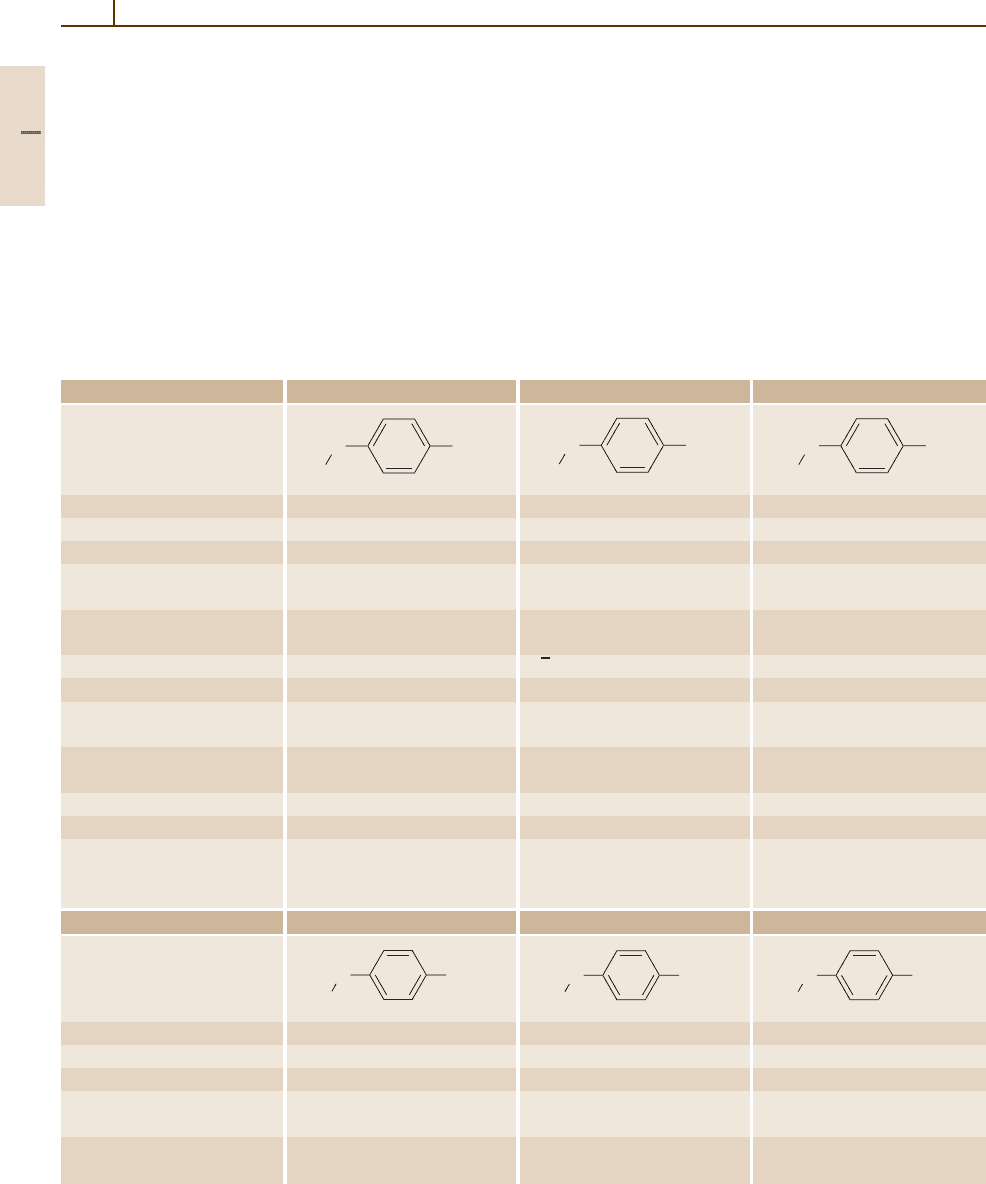
946 Part 5 Special Structures
5.1.2 Physical Properties of the Most Common
Liquid Crystalline Substances
The compounds are arranged in the tables on the ba-
sis of the number and priority of fragments. The order
principles for mesogenic groups are the number of rings
and bridges, and the priority of rings, bridges, and side
groups.
Priority of rings:
benzene > cyclohexane > heterocycles >
halogen-substituted benzenes .
Table 5.1-2 Acids
Number/common name 1 2 3
Substance
COOHO
H
7
C
3
COOHO
H
9
C
4
COOHO
H
11
C
5
Formula C
10
H
12
O
3
C
11
H
14
O
3
C
12
H
16
O
3
Molar mass (g/mol) 180.205 194.232 208.26
CAS-RN 5438-19-7 1498-96-0 15872-41-0
Temperatures of phase Cr 146.0 N 156.0Is Cr 147.5 N 161.0Is Cr 124.4 N 151.4Is
transitions T
tr
(
◦
C)
Enthalpies of phase transitions 16.7 (Cr–N), 2.5 (N–Is) 19.7 (Cr–N), 2.4 (N–Is) 18.0 (Cr–N), 1.8 (N–Is)
∆H
tr
(kJ/mol)
Crystallographic space group P2
1
/c P1 P2
1
Order parameter S 0.533 (149
◦
C) 0.538 (154
◦
C) 0.587 (137
◦
C)
Density (g/cm
3
) 1.0095 (N, 150
◦
C), 1.0079 (N, 150
◦
C), 0.9945 (N, 145
◦
C),
1.0008 (Is, 159
◦
C) 0.9883 (Is, 165
◦
C) 0.9721 (Is, 155
◦
C)
Refractive index n n
e
1.632, n
o
1.457 n
e
1.615, n
o
1.449 n
e
1.602, n
o
1.456
(N, 546 nm, 140.5
◦
C) (N, 589 nm, 149
◦
C) (N, 546 nm, 140.5
◦
C)
Dielectric anisotropy ∆ε − 0.079 (T = 0.977 T
N–Is
) 0.042 (T = 0.977 T
N–Is
)
Dynamic viscosity η (mPa s) 1.81 (149
◦
C), 2.63 (159
◦
C) 1.88 (151
◦
C), 2.62 (165
◦
C) 2.37 (145
◦
C), 3.30 (155
◦
C)
Diffusion coefficient D (m
2
/s) − D
⊥
= 4×10
−10
, D
⊥
= 4×10
−10
,
D
= 14×10
−10
D
= 12 ×10
−10
(1000/T = 2.38) (1000/T = 2.45)
Number/common name 4 5 (HOBA) 6 (OOBA)
Substance
COOHO
H
13
C
6
COOHO
H
15
C
7
COOHO
H
17
C
8
Formula C
13
H
18
O
3
C
14
H
20
O
3
C
15
H
22
O
3
Molar mass (g/mol) 222.287 236.314 250.341
CAS-RN 1142-39-8 15872-42-1 2493-84-7
Temperatures of phase Cr
75 Cr 105.4 N 153.2Is Cr 94.0 C 102.0 N 147.5Is Cr 100.5 C 107.5 N 147.0Is
transitions T
tr
(
◦
C)
Enthalpies of phase transitions 13.8 (Cr–N), 3.3 (N–Is), 19.2(Cr–C),2.5 (N–Is) 12.7(Cr–C),1.1 (C–N), 2.1 (N–Is)
∆H
tr
(kJ/mol) 6.7(Cr
–Cr)
Priority of bridges:
C
n
H
m
> CH
=
N > N
=
N > N
=
N(O)>COO .
Homologues are arranged in order of increasing
number of carbon atoms in the alkyl chains.
We have attempted to include all of the most
common liquid crystals, fromthe traditional “model sub-
stances” (e.g. 5CB, MBBA, and PAA) to substances used
in modern applications.
Part 5 1.2
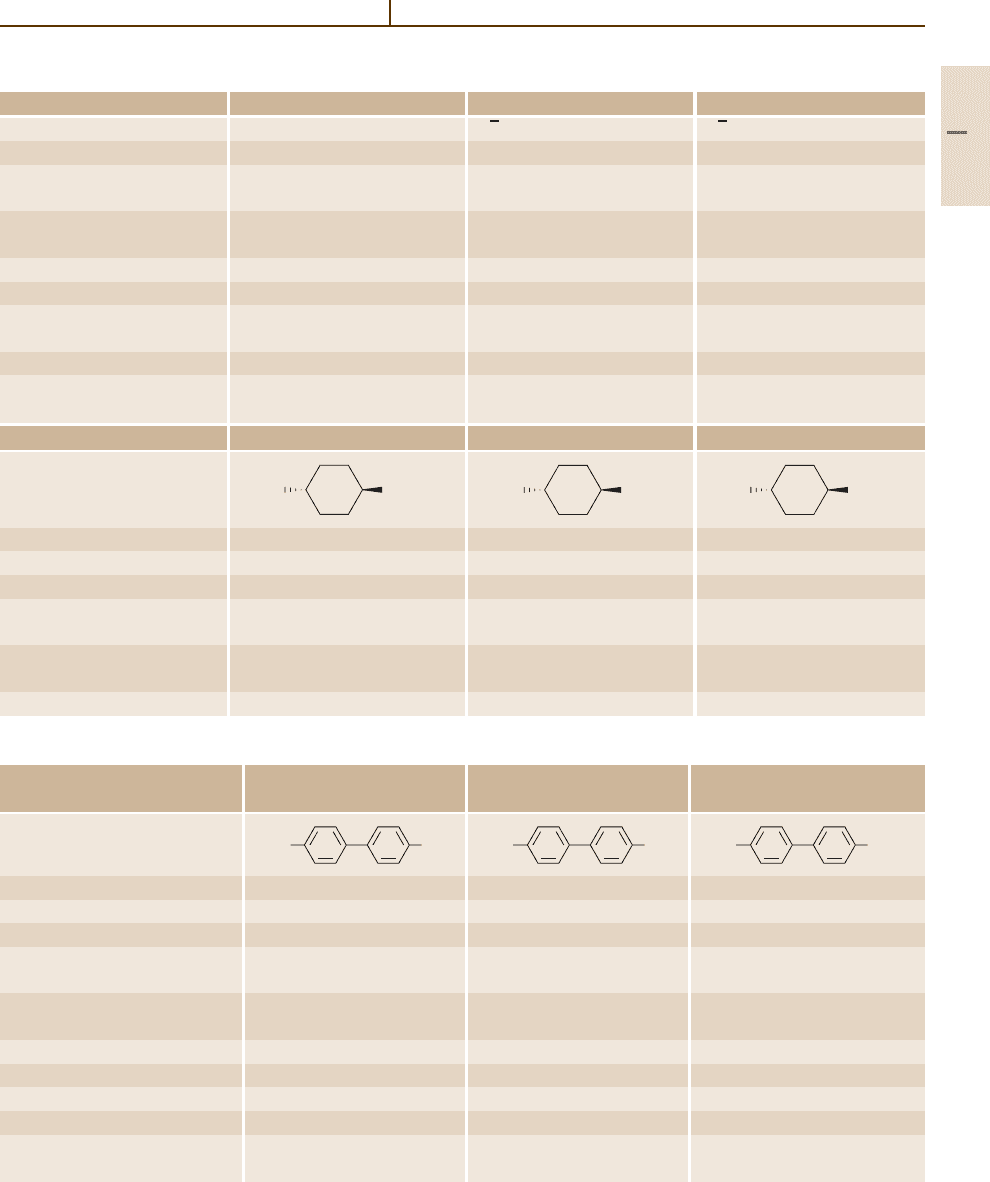
Liquid Crystals 1.2 Physical Properties of the Most Common Liquid Crystalline Substances 947
Table 5.1-2 Acids, cont.
Number/common name 4 5 (HOBA) 6 (OOBA)
Crystallographic space group P2
1
/c (Cr), P1 (Cr
) P1 P1
Order parameter S 0.611 (129
◦
C) 0.626 (123
◦
C) 0.615 (128
◦
C)
Density (g/cm
3
) 0.983 (N, 146
◦
C), 0.970 (N, 140
◦
C), 0.961 (N, 140
◦
C),
0.969 (Is, 156
◦
C) 0.959 (Is, 150
◦
C) 0.945 (Is, 150
◦
C)
Refractive index n n
e
1.595, n
o
1.453 n
e
1.580, n
o
1.452 n
e
1.578, n
o
1.450
(546 nm, N, 142.5
◦
C) (546 nm, N, 137.5
◦
C) (546 nm, N, 138.5
◦
C)
Dielectric anisotropy ∆ε 0.052 (T = 0.977 T
N–Is
) 0.038 (T = 0.977 T
N–Is
) 0.037 (T = 0.977 T
N–Is
)
Dynamic viscosity η (mPa s) 2.61 (146
◦
C), 3.46 (157
◦
C) 3.02 (137
◦
C), 3.95 (150
◦
C) 3.19 (140.5
◦
C), 3.97 (151
◦
C)
Thermal conductivity 0.137 (N, 115
◦
C), 0.146 (N, 130
◦
C), −
(W/(mK))
0.159 (Is, 157
◦
C) 0.162 (Is, 159
◦
C)
Sound velocity v (m/s) 972 (3.36 GHz, 141
◦
C) 1021 (3.40 GHz, 135
◦
C) 1050 (3.63 GHz, 137
◦
C)
Diffusion coefficient D (m
2
/s) D
⊥
= 2×10
−10
, D
= 8×10
−10
− −
(1000/T = 2.45)
Number/common name 7 8 9
Substance
COOHH
11
C
5
COOHH
13
C
6
COOHH
15
C
7
Formula C
12
H
22
O
2
C
13
H
24
O
2
C
14
H
26
O
2
Molar mass (g/mol) 198.308 212.335 226.362
CAS-RN 32829-29-1 38289-30-4 32829-31-5
Temperatures of phase Cr 53.0(B45.0) N 105.0Is Cr 31.7B47.2N96.4Is Cr
31.0Cr54.0B77.0
transitions T
tr
(
◦
C) N 104.0Is
Enthalpies of phase transitions 20.9 (Cr–N), 1.1 (N–Is) 15.7(Cr–B),1.0 (B–N), 13.4(Cr
–Cr), 5.2(Cr–B),
∆H
tr
(kJ/mol) 0.5 (N–Is) 2.3 (B–N), 1.1 (N–Is)
∆ε (N, 90
◦
C, 500 kHz) 0.05 − 0.05
Table 5.1-3 Two-ring systems without bridges
Number/common name 10 11 12
(2CB, K6, RO-CM-5106) (3CB, K9, RO-CM-5109) (4CB, K12, RO-CM-5112)
Substance
CNH
5
C
2
CNH
7
C
3
CNH
9
C
4
Formula C
15
H
13
N C
16
H
15
N C
17
H
17
N
Molar mass (g/mol) 207.278 221.305 235.332
CAS-RN 58743-75-2 58743-76-3 52709-83-8
Temperatures of phase Cr 75.0(N22.0) Is Cr 67.3(N30.3) Is Cr 48.0(N16.5) Is
transitions T
tr
(
◦
C)
Enthalpies of phase transitions 17.2 (Cr–Is) 26.8 (Cr–Is), 0.3 (N–Is) 23.0 (Cr–Is)
∆H
tr
(kJ/mol)
Crystallographic space group − P2
1
/c P2
1
/c
Anisotropy of refractive index ∆n 0.206 0.211 0.202
Dielectric constant ε ∆ε +18.9 ε
25.8, ε
⊥
6.9(20
◦
C) ∆ε +17
Kinematic viscosity ν (mm
2
/s) 5(70
◦
C) 23 (extra, 20
◦
C), 7 (70
◦
C) 7.5(70
◦
C)
Dipole moment µ (D), 25
◦
C 4.81 (CCl
4
), 4.96 (C
6
H
14
), 4.72 (CCl
4
), 5.02 (C
6
H
14
), 4.73 (CCl
4
), 5.04 (C
6
H
14
),
4.90 (C
6
H
12
), 5.01 (C
6
H
6
) 4.93 (C
6
H
12
), 4.93 (C
6
H
6
) 4.94 (C
6
H
12
), 4.99 (C
6
H
6
)
Part 5 1.2
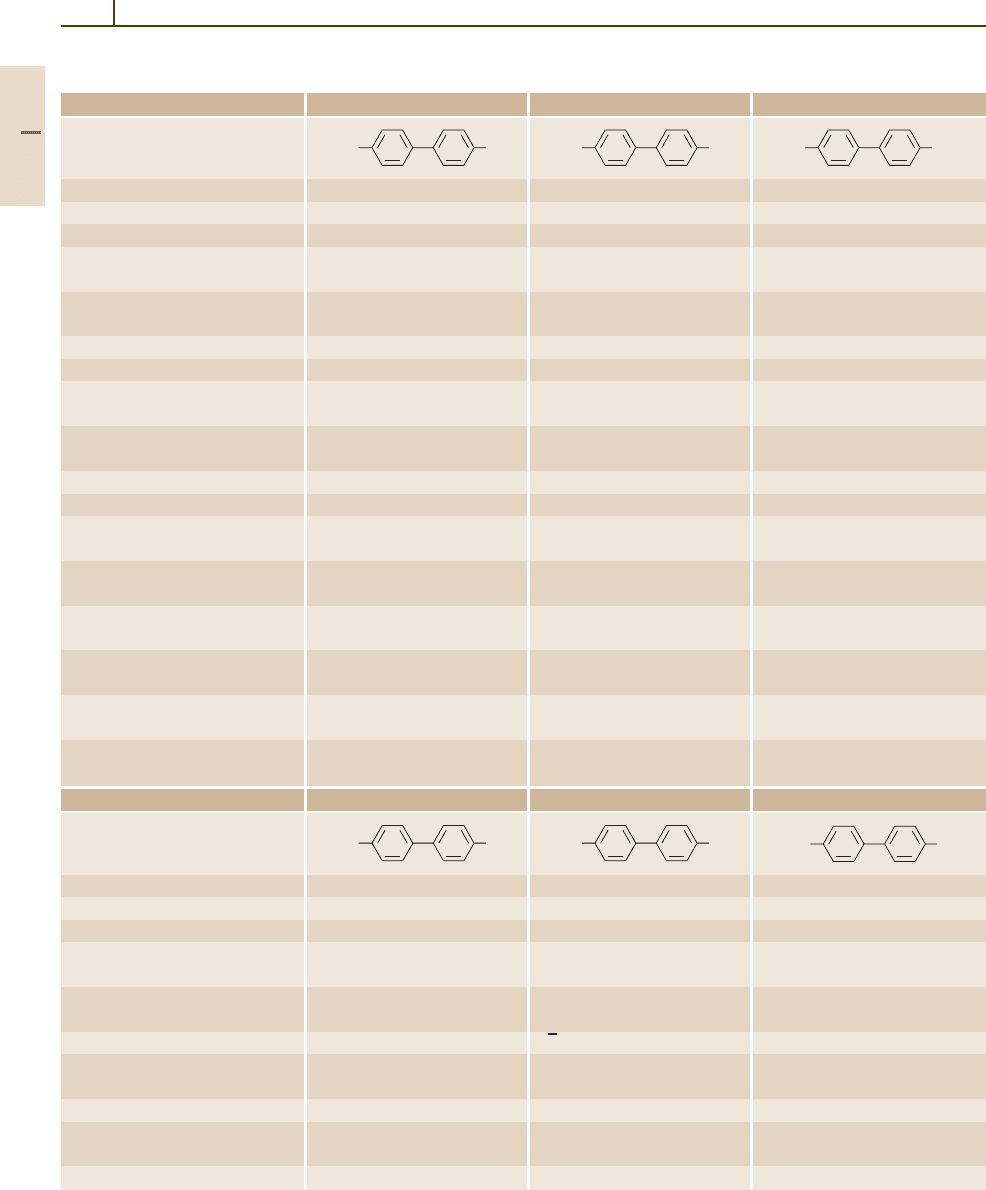
948 Part 5 Special Structures
Table 5.1-3 Two-ring systems without bridges, cont.
Number/common name 13 (5CB, K15, RO-CM-5115) 14 (6CB, K18, RO-CM-5118) 15 (7CB, K21, RO-CM-5121)
Substance
CNH
11
C
5
CNH
13
C
6
CNH
15
C
7
Formula C
18
H
19
N C
19
H
21
N C
20
H
23
N
Molar mass (g/mol) 249.359 263.386 277.413
CAS-RN 40817-08-1 41122-70-7 41122-71-8
Temperatures of phase Cr 24.0N35.3Is Cr 14.3N30.1Is Cr
15.0Cr30.0N42.8Is
transitions T
tr
(
◦
C)
Enthalpies of phase transitions 17.2 (Cr–N), 0.4 (N–Is) 24.3 (Cr–N), 0.4 (N–Is) 25.9 (Cr–N), 0.9 (N–Is)
∆H
tr
(kJ/mol)
Crystallographic space group P2
1
/a P1 P1
Order parameter S 0.64 (24
◦
C) − 0.65 (29
◦
C)
Density (g/cm
3
) 1.022 (N, 24
◦
C), 1.017 (N, 20
◦
C), 1.001 (N, 29
◦
C),
1.016 (N, 30
◦
C) 0.991 (N, 39
◦
C)
Refractive index n (589 nm) n
e
1.716, n
o
1.533 n
e
1.687, n
o
1.531 n
e
1.679, n
o
1.522
(N, 24
◦
C, 589 nm) (N, 20
◦
C, 633 nm) (N, 32
◦
C, 589 nm)
Dielectric constant ε ε
20, ε
⊥
7(25
◦
C, 1.5kHz) ε
14.45, ε
⊥
7.2(28
◦
C, 1 kHz) ε
13.55, ε
⊥
6.8(41
◦
C, 1 kHz)
Viscosity η 28 mPa s (25
◦
C) ν 46mm
2
/s(20
◦
C) ν 26 mm
2
/s(20
◦
C)
Surface tension (mN/m) 33 (N, 20
◦
C), 28 (N, 30
◦
C), 27.4 (N, 22
◦
C), 28.0 (Is, 32
◦
C) 26.3 (N, 37
◦
C), 27.5 (Is, 47
◦
C)
28.3 (Is, 40
◦
C)
Thermal conductivity k
⊥
0.124, k
0.242 k
⊥
0.126, k
0.223 k
⊥
0.127, k
0.269
(W/(mK)) (N, 25
◦
C)
Magnetic susceptibility 113.5(25.6
◦
C) 101.5(20
◦
C) 102.0(33
◦
C)
∆χ (m
3
/kg) (×10
−12
)
Sound velocity v (m/s) v
1740, v
⊥
1680 v
1776, v
⊥
1712 v
1675, v
⊥
1640
(14.75 GHz, 30
◦
C) (14.75 GHz, 25
◦
C) (14.75GHz, 38
◦
C)
Diffusion coefficient D (m
2
/s) D
⊥
6.8×10
−8
, D
12.7×10
−8
D
⊥
6.4×10
−8
, D
10.9×10
−8
D
⊥
6.8×10
−8
, D
14.4×10
−8
(25
◦
C) (25
◦
C) (25
◦
C)
Dipole moment µ (D), 25
◦
C 4.85 (CCl
4
), 5.08 (C
6
H
14
), 4.83 (CCl
4
), 5.09 (C
6
H
14
), 4.74 (CCl
4
), 5.11 (C
6
H
14
),
4.95 (C
6
H
12
), 4.93 (C
6
H
6
) 5.01 (C
6
H
12
), 4.98 (C
6
H
6
) 4.94 (C
6
H
12
), 4.97 (C
6
H
6
)
Number/common name 16 (8CB, K24) 17 (9CB, K27) 18 (10CB, K30)
Substance
CNH
17
C
8
CNH
19
C
9
CNH
21
C
10
Formula C
21
H
25
N C
22
H
27
N C
23
H
29
N
Molar mass (g/mol) 291.44 305.467 319.494
CAS-RN 52709-84-9 52709-85-0 59454-35-2
Temperatures of phase Cr 21.5A33.5N40.5Is Cr 42.0A48.0N49.5Is Cr 44.0A54.5Is
transitions T
tr
(
◦
C)
Enthalpies of phase transitions 28.3 (Cr–A), 0.2 (A–N), 33.5 (Cr–A), 0.6 (A–N), 33.1 (Cr–A), 2.8 (N–Is)
∆H
tr
(kJ/mol) 0.7 (N–Is) 1.7 (N–Is)
Crystallographic space group P2
1
/n P1 P2
1
/n
Density (g/cm
3
) 0.991 (A, 32.5
◦
C), 0.981 0.973 (A, 47.7
◦
C), 0.968 −
(N, 40
◦
C), 0.978 (Is, 41
◦
C) (N, 49.5
◦
C)
Refractive index n (589 nm) n
e
1.657, n
o
1.524 (N, 37.4
◦
C) n
e
1.638, n
o
1.519 (N, 49
◦
C) −
Dielectric constant ε (1 kHz) ε
12.8, ε
⊥
5.3(N,34
◦
C), ε
12.5, ε
⊥
5.1(44
◦
C) ε 8.8 (Is, 64.5
◦
C)
ε
12.4, ε
⊥
4.8(A,28
◦
C)
Dynamic viscosity η (mPa s) 35 (N, 33.5
◦
C) − −
Part 5 1.2
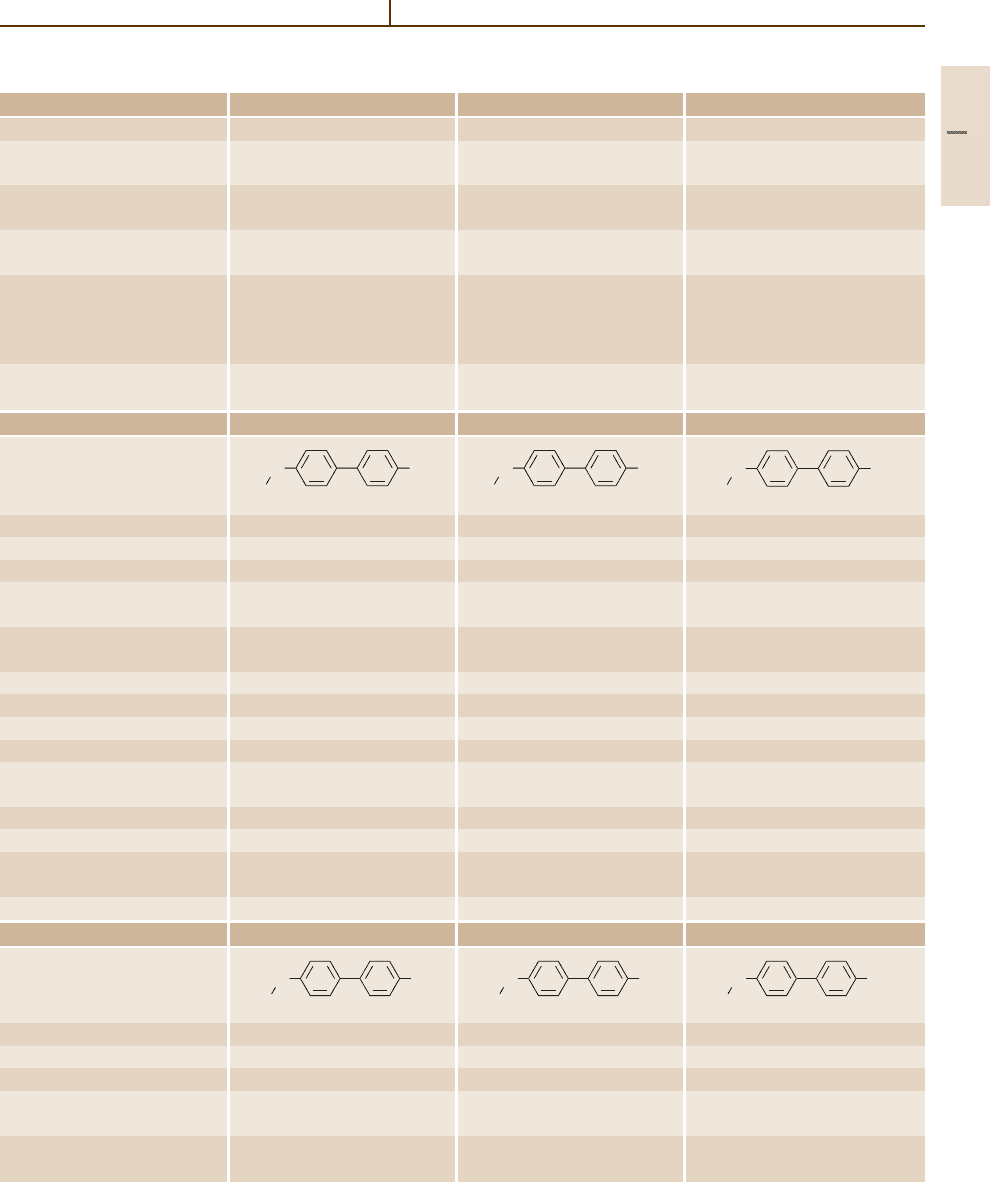
Liquid Crystals 1.2 Physical Properties of the Most Common Liquid Crystalline Substances 949
Table 5.1-3 Two-ring systems without bridges, cont.
Number/common name 16 (8CB, K24) 17 (9CB, K27) 18 (10CB, K30)
Surface tension (mN/m) 25.5 (N, 35
◦
C), 26.2 (Is, 41
◦
C) − −
Thermal conductivity k
⊥
0.130, k
0.276 (A, 30
◦
C), k
⊥
0.130, k
0.310 (40
◦
C) −
(W/(mK))
k
⊥
0.132, k
0.254 (N, 35
◦
C)
Magnetic susceptibility 88 (35
◦
C) 88.5(48.9
◦
C) −
∆χ(m
3
/kg) (×10
−12
)
Sound velocity v (m/s) v
1596, v
⊥
1545 v
1740, v
⊥
1680 −
(14.75 GHz, 39
◦
C) (14.75 GHz, 44.5
◦
C)
Diffusion coefficient D (m
2
/s) D
⊥
6×10
−8
, D
12× 10
−8
D
⊥
6.6×10
−8
, D
15.2×10
−8
−
(A, 30
◦
C), (A, 40
◦
C)
D
⊥
5.8×10
−8
, D
10× 10
−8
(N, 35
◦
C)
Dipole moment µ (D), 25
◦
C 4.78 (CCl
4
), 5.12 (C
6
H
14
), 4.73 (CCl
4
), 5.11 (C
6
H
14
), 4.76 (CCl
4
), 5.10 (C
6
H
14
),
4.93 (C
6
H
12
), 5.00 (C
6
H
6
) 4.94 (C
6
H
12
), 4.94 (C
6
H
6
) 5.00 (C
6
H
12
), 5.00 (C
6
H
6
)
Number/common name 19 (3OCB, M9, RO-CM-5309) 20 (4OCB, M12) 21 (5OCB, M15, RO-CM-5315)
Substance
CNO
H
7
C
3
CNO
H
9
C
4
CNO
H
11
C
5
Formula C
16
H
15
NO C
17
H
17
NO C
18
H
19
NO
Molar mass (g/mol) 237.304 251.331 265.368
CAS-RN 52709-86-1 52709-87-2 52364-71-3
Temperatures of phase Cr 71.5(N64.0) Is Cr 78.0(N75.5) Is Cr
48.0Cr53.0N68.0Is
transitions T
tr
(
◦
C)
Enthalpies of phase transitions 19.2 (Cr–Is) 23.4 (Cr–Is) 28.9 (Cr–N), 0.2 (N–Is)
∆H
tr
(kJ/mol)
Crystallographic space group P2
1
/c Pca2
1
P2
1
/n
Order parameter S − − 0.63 (55
◦
C)
Density (g/cm
3
) 1.19 (Cr) 1.14 (Cr) 1.042 (N, 61.5
◦
C), 1.029 (Is, 70
◦
C)
Refractive index n (589 nm) − − n
e
1.697, n
o
1.528 (N, 55
◦
C)
Dielectric constant ε (1 kHz) − ∆ε +28.7, ε
⊥
+7.5 ∆ε +8.5, ε
16.7(T = 0.98T
N–Is
)
(20
◦
C, extra)
Kinemamic viscosity ν (mm
2
/s) 10 (Is, 80
◦
C) 10 (75
◦
C) 20 (53
◦
C), 10 (85
◦
C)
Surface tension (mN/m) − − 33.2 (N, 51
◦
C), 31.9 (Is, 70
◦
C)
Magnetic susceptibility − − 87 (58
◦
C), 98 (50
◦
C)
∆χ (m
3
/kg) (×10
−12
)
Dipole moment µ (D) − 5.1 −
Number/common name 22 (6OCB, M18) 23 (7OCB, M21) 24 (8OCB, M24, RO-CM-5324)
Substance
CNO
H
13
C
6
CNO
H
15
C
7
CNO
H
17
C
8
Formula C
19
H
21
NO C
20
H
23
NO C
21
H
25
NO
Molar mass (g/mol) 279.385 293.412 307.44
CAS-RN 41424-11-7 52364-72-4 52364-73-5
Temperatures of phase Cr
44.0Cr57.0N75.5Is Cr
45.5Cr53.5N75.0Is Cr
46.0Cr
51.0Cr54.5
transitions T
tr
(
◦
C) A67.0N80.0Is
Enthalpies of phase transitions 29.7 (Cr–N), 0.8 (N–Is) 28.9 (Cr–N), 0.6 (N–Is) 28.5 (Cr–A), 0.1 (A–N), 0.8 (N–Is)
∆H
tr
(kJ/mol)
Part 5 1.2
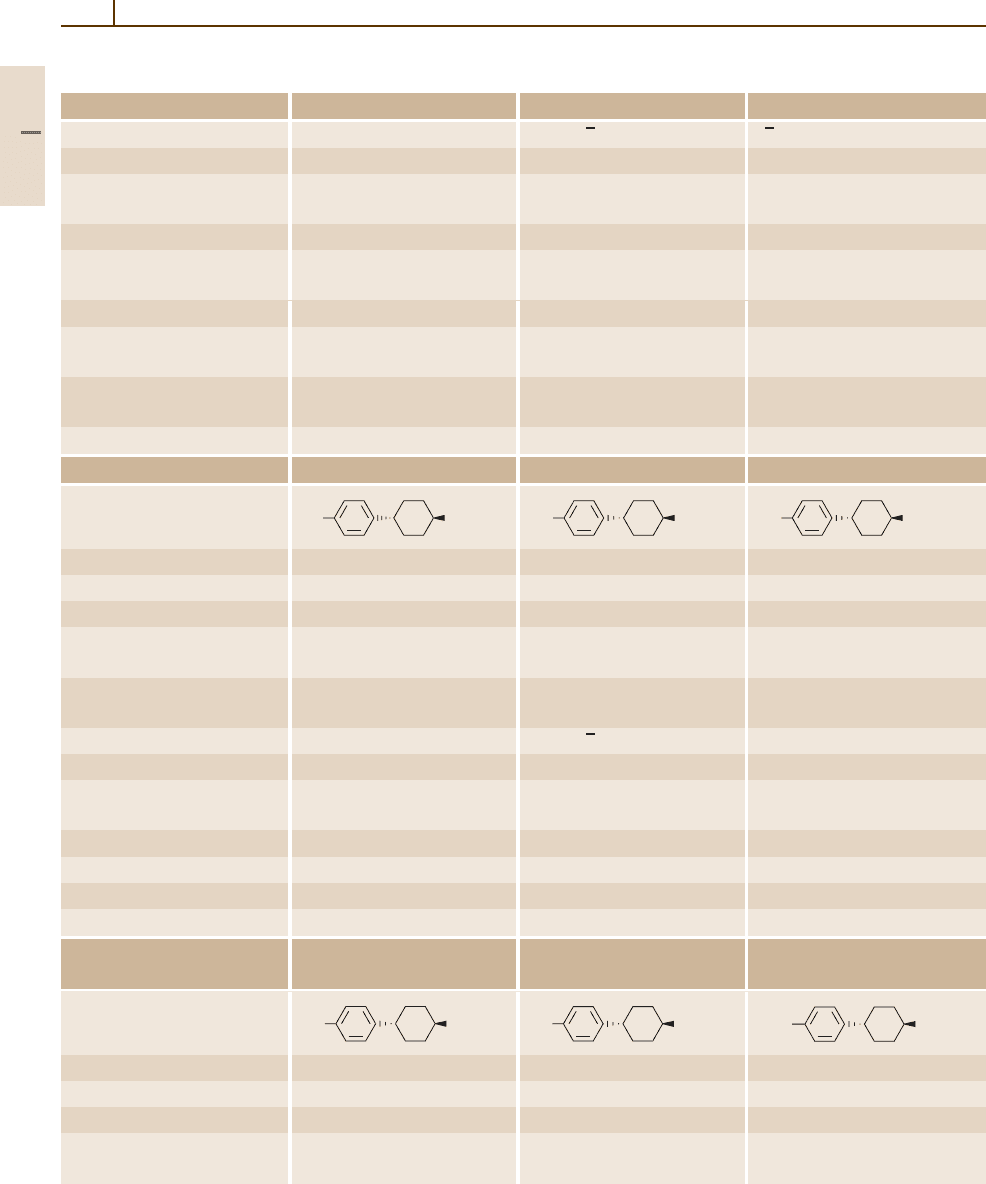
950 Part 5 Special Structures
Table 5.1-3 Two-ring systems without bridges, cont.
Number/common name 22 (6OCB, M18) 23 (7OCB, M21) 24 (8OCB, M24, RO-CM-5324)
Crystallographic space group − P2
1
/c, P
1
P
1
Order parameter S − 0.61 (63
◦
C)
Density (g/cm
3
) 1.017 (N, 71
◦
C), 1.0051 (N, 63
◦
C), 0.990 (N, 75
◦
C),
1.025 (N, 63
◦
C) 0.9869 (Is, 79.5
◦
C) 0.977 (Is, 85
◦
C)
Refractive index n (589 nm) n
e
1.72, n
o
1.50 (60
◦
C) n
e
1.6734, n
o
1.5155 (60
◦
C) n
e
1.647, n
o
1.509 (71
◦
C)
Dielectric constant ε (1 kHz) ∆ε +8.0, ∆ε +7.5, ∆ε +8.0(N,74
◦
C)
ε
15.8(T = 0.98T
N–Is
) ε
15.0(T = 0.98T
N–Is
)
Kinematic viscosity ν (mm
2
/s) 17 (60
◦
C), 12 (85
◦
C) 10 (70
◦
C), 30 (50
◦
C) 16 (70
◦
C), 12 (85
◦
C)
Surface tension (mN/m) − − 36.5 (A, 60), 35.4 (N, 70),
30.5 (Is, 80)
Magnetic susceptibility 88 (67
◦
C), 80 (71
◦
C) 71 (70
◦
C), 87.5(60
◦
C) 83 (70.6
◦
C)
∆χ (m
3
/kg) (×10
−12
)
Dipole moment µ (D) 5.2 4.9 5.2 (CCl
4
)
Number/common name 25 (PCH-3) 26 (PCH-4) 27 (PCH-5)
Substance
C
3
H
7
NC
C
4
H
9
NC C
5
H
11
NC
Formula C
16
H
21
N C
17
H
23
N C
18
H
25
N
Molar mass (g/mol) 227.352 241.38 255.407
CAS-RN 61203-99-4 61204-00-0 61204-01-1
Temperatures of phase Cr 42.7N45.9Is Cr 41.0N39.0Is Cr 30.0N55.0Is
transitions T
tr
(
◦
C)
Enthalpies of phase transitions 19.0 (Cr–N), 0.7 (N–Is) 22.2 (Cr–Is) 18.0 (Cr–N), 0.9 (N–Is)
∆H
tr
(kJ/mol)
Crystallographic space group C2/c P2
1
/c, P
1
−
Order parameter S 0.64 (43
◦
C) − 0.54 (43
◦
C)
Density (g/cm
3
) 0.9672 (N, 43
◦
C), 0.962 (N, 35
◦
C), 0.967 (N, 25
◦
C),
0.9571 (Is, 46.5
◦
C) 0.951 (Is, 43
◦
C) 0.932 (Is, 60
◦
C)
Refractive index n (589 nm) n
e
1.582, n
o
1.492 (N, 43
◦
C) n
e
1.579, n
o
1.498 (N, 37
◦
C) n
e
1.600, n
o
1.492 (N, 40
◦
C)
Dielectric constant ε (1 kHz) ε
19.3, ε
⊥
5.5(T = 0.95T
N–Is
) ∆ε +11 (20
◦
C) ε
14.4, ε
⊥
5.2(39
◦
C)
Viscosity (20
◦
C) η 19.2mPas ν 23mm
2
/s ν 23 mm
2
/s
Dipole moment µ (D) 3.9 − 4.1
Number/common name 28 (PCH-7) 29 (PCH-8) 30 (PCH-32, RO-CM-4232,
ZLI-1484)
Substance
C
7
H
15
NC
C
8
H
17
NC
C
3
H
7
H
5
C
2
Formula C
20
H
29
N C
21
H
31
N C
17
H
26
Molar mass (g/mol) 283.461 297.488 230.397
CAS-RN 61204-03-3 83626-40-8 82991-47-7
Temperatures of phase Cr 30.0N57.8Is Cr 37.0N55.0Is Cr −1Is
transitions T
tr
(
◦
C)
Part 5 1.2
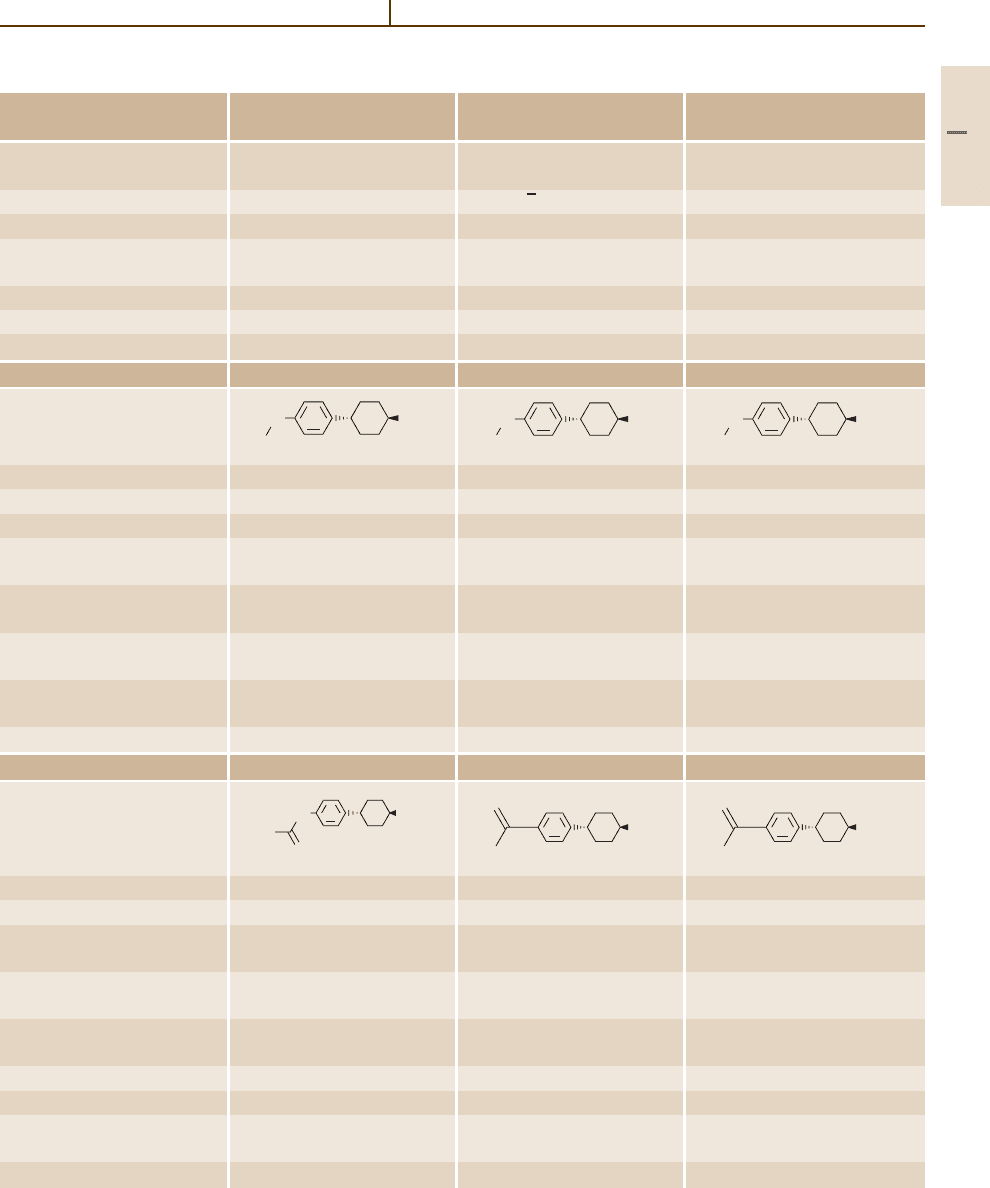
Liquid Crystals 1.2 Physical Properties of the Most Common Liquid Crystalline Substances 951
Table 5.1-3 Two-ring systems without bridges, cont.
Number/common name 28 (PCH-7) 29 (PCH-8) 30 (PCH-32, RO-CM-4232,
ZLI-1484)
Enthalpies of phase transitions 25.5 (Cr–N), 1.0 (N–Is) − 18.4 (Cr–Is)
∆H
tr
(kJ/mol)
Crystallographic space group − P2
1
/c, P
1
(Cr
) −
Order parameter S 0.47 (47
◦
C) − −
Density (g/cm
3
) 0.952 (N, 30
◦
C), 0.941 (N, 37
◦
C), 0.909 (20
◦
C)
0.915 (Is, 67
◦
C) 0.915 (Is, 62
◦
C)
Refractive index n (589 nm) n
e
1.590, n
o
1.482 (47
◦
C) − 1.514 (20
◦
C)
Dielectric constant ε (1 kHz) ε
12.9, ε
⊥
4.2(31
◦
C) − ε 2.293, ∆ε +0.5(20
◦
C, extra)
Kinematic viscosity ν (mm
2
/s) 28 (extra, 20
◦
C) − 4 (extra, 20
◦
C)
Number/common name 31 (PCH-301, ZLI-2446) 32 (PCH-302, ZLI-1476) 33 (PCH-304, ZLI-1477)
Substance
O
H
3
C
C
3
H
7
O C
3
H
7
H
5
C
2
O C
3
H
7
H
9
C
4
Formula C
16
H
24
O C
17
H
26
O C
19
H
30
O
Molar mass (g/mol) 232.369 246.396 274.45
CAS-RN 81936-32-5 80944-44-1 79709-84-5
Temperatures of phase Cr 32.0(N10.0) Is Cr 40.8(N37.8) Is Cr 35.5(N33.0) Is
transitions T
tr
(
◦
C)
Enthalpies of phase transitions 17.6 (Cr–Is) 26.4 (Cr–Is), 0.7 (N–Is) 30.6 (Cr–Is), 0.5 (N–Is)
∆H
tr
(kJ/mol)
Anisotropy of refractive index 0.09 (extra) 0.09 (extra) 0.09 (extra)
∆n (20
◦
C, 589 nm)
Dielectric anisotropy ∆ε −0.5(extra) −0.5(extra) −0.5(extra)
(20
◦
C, 1 kHz)
Kinematic viscosity ν (mm
2
/s) 6 (extra, 20
◦
C) 7 (extra, 20
◦
C) 10 (extra, 20
◦
C)
Number/common name 34 (H33, ZLI-1305) 35 36
Substance
O C
3
H
7
H
7
C
3
O
C
3
H
7
H
5
C
2
O
C
5
H
11
H
5
C
2
O
Formula C
19
H
28
O
2
C
18
H
26
O C
20
H
30
O
Molar mass (g/mol) 288.434 258.407 286.462
Temperatures of phase Cr 11.0B26.1N30.3Is Cr 49.2N56.5Is Cr 56.6N68.8Is
transitions T
tr
(
◦
C)
Enthalpies of phase transitions 16.4(Cr–B),4.9 (B–N), − −
∆H
tr
(kJ/mol) 0.4 (N–Is)
Refractive index n (589 nm) ∆n 0.09 (20
◦
C) n
e
1.589, n
e
1.574,
n
o
1.497 (T = 0.95T
N–Is
) n
o
1.487 (T = 0.95T
N–Is
)
Dielectric constant ε (1 kHz) ∆ε −1.5(20
◦
C) ε
9.0, ε
⊥
7.6(T = 0.95T
N–Is
) ε
8.3 ε
⊥
6.9(T = 0.95T
N–Is
)
Viscosity ν (20
◦
C) 15 mm
2
/s(extra) − −
Diamagnetic anisotropy ∆χ − 25.3 26.1
(m
3
/mol) (×10
−12
)
Dipole moment µ (D) − 3.02 3.1
Part 5 1.2
